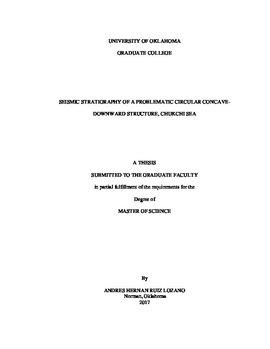| dc.description.abstract | A circular concave-downward structure (CCDS) and its structural features and seismic facies can be observed in several 2D seismic lines imaging the Chukchi Sea planning area. The area in question is largely underexplored and the data coverage is limited. Nonetheless, it is possible to make a proper assessment of this geological problem, or at least an educated guess through the application of seismic interpretation techniques that combine both geophysical and geological principles such as seismic stratigraphy and fault mechanical stratigraphy to propose a solution to the geological process responsible.
Derived from the principles of Steno’s law of superposition and cross cutting relations, and the deterministic and empirical description of rock strength dependence with depth and age, fault mechanical stratigraphy is useful to analyze faulting chronographically. When combined with seismic stratigraphy, an approximate geological age can be given to the faults. In the study of this structure, the analysis of the ages of the faults associated with the structure is crucial.
From the observations derived from the seismic stratigraphic method of interpretation and the fault mechanical stratigraphy analysis, three geological hypotheses were proposed to explain this structure: reactive diapirism, wrench fault-associated gas chimney, and a complex meteorite impact crater.
The fault mechanical stratigraphy of the faults related to the structure constrains the timing of the faults related to the structure and of the structure itself to a very limited time range in the middle Eocene. Together with a concentric-ring geometry of the faults, a central uplift feature at the base of the structure, and chaotic reflectors above and around this central uplift strongly suggests it is a complex meteorite impact structure.
Complex meteorite impact crater morphology can be resolved within seismic resolution; their diameter is larger than 4 km. Three main distinctive features of these relatively large structures can be interpreted in seismic data: collapse faults rimming the crater produced by gravitational failure towards the center of the crater, a central uplift at the center of the crater generated by the rebound of the energy of the impact, and impact breccia infill. | en_US |
